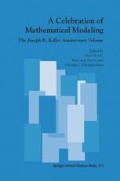Abstract
A class of numerical methods to solve wave problems in unbounded domains is based on truncating the infinite domain via an artificial boundary B and applying an appropriate boundary condition on B. The latter is called a Non-Reflecting Boundary Condition (NRBC). In this paper we (a) briefly recount the history of NRBC development and related issues, (b) explain the notion of high-order local NRBCs, (c) show how to derive such NRBCs for the dispersive (Klein-Gordon) wave equation, (d) give a numerical example, and (e) mention how Joe Keller is related to all this.
Access this chapter
Tax calculation will be finalised at checkout
Purchases are for personal use only
Preview
Unable to display preview. Download preview PDF.
References
R.J. Astley (1996), “Transient Wave Envelope Elements for Wave Problems,” J. Sound Vib., 192, 245–261.
A. Bayliss and E. Turkel (1980), “Radiation Boundary Conditions for Wave-Like Equations,” Comm. Pure Appl. Math., 33, 707–725.
J.P. Bérenger (1994), “A Perfectly Matched Layer for the Absorption of Electromagnetic Waves,” J. Comput. Phys., 114, 185–200.
P. Bettess (1977), “Infinite Elements,” Int. J. Numer. Meth. Engng., 11, 53–64.
D.S. Burnett (1994), “A Three-Dimensional Acoustic Infinite Element Based on a Prolate Spheroidal Multipole Expansion,” J. Acoust. Soc. Am., 96, 2798–2816.
F. Collino (1993), “High Order Absorbing Boundary Conditions for Wave Propagation Models. Straight Line Boundary and Corner Cases,” in Proc. 2nd Int. Conf. on Mathematical & Numerical Aspects of Wave Propagation, R. Kleinman et al., Eds., SIAM, Delaware, pp. 161–171.
B. Engquist and A. Majda (1979), “Radiation Boundary Conditions for Acoustic and Elastic Calculations,” Comm. Pure Appl. Math., 32, 313–357.
D. Givoli (1991), “Non-Reflecting Boundary Conditions: A Review,” J. Comput. Phys., 94, 1–29.
D. Givoli (1999), “Exact Representations on Artificial Interfaces and Applications in Mechanics,” Appl. Mech. Rev., 52, 333–349.
D. Givoli (2001), “High-Order Non-Reflecting Boundary Conditions Without High-Order Derivatives,” J. Comput. Phys., 170, 849–870.
D. Givoli and J.B. Keller (1989), “A Finite Element Method for Large Domains,” Comput. Meth. Appl. Mech. Engng., 76, 41–66.
D. Givoli and B. Neta (2003), “High-Order Non-Reflecting Boundary Scheme for Time-Dependent Waves,” J. Comput. Phys., 186, 24–46.
D. Givoli and I. Patlashenko (2002), “An Optimal High-Order Non-Reflecting Finite Element Scheme for Wave Scattering Problems,” Int. J. Numer. Meth. Engng., 53, 2389–2411.
M.J. Grote and J.B. Keller (1995), “Exact Nonreflecting Boundary Conditions for the Time Dependent Wave Equation,” SIAM J. of Appl. Math., 55, 280–297.
M.J. Grote and J.B. Keller (1996), “Nonreflecting Boundary Conditions for Time Dependent Scattering,” J. Comput. Phys., 127, 52–65.
M.J. Grote and J.B. Keller (2000), “Nonreflecting Boundary Conditions for Elastic Waves,” SIAM J. Appl. Math., 60, 803–819.
M.N. Guddati and J.L. Tassoulas (2000), “Continued-Fraction Absorbing Boundary Conditions for the Wave Equation,” J. Comput. Acoust., 8, 139–156.
T. Hagstrom (1999), “Radiation Boundary Conditions for the Numerical Simulation of Waves,” Acta Numerica, 8, 47–106.
T. Hagstrom and S.I. Hariharan (1998), “A Formulation of Asymptotic and Exact Boundary Conditions Using Local Operators,” Appl. Nu-mer. Math., 27, 403–416.
T. Hagstrom and H.B. Keller (1986), “Exact Boundary Conditions at an Artificial Boundary for Partial Differential Equations in Cylinders,” SIAM J. Math. Anal., 17, 322–341.
R.L. Higdon (1994), “Radiation Boundary Conditions for Dispersive Waves,” SIAM J. Numer. Anal., 31, 64–100.
H.B. Keller (1976), Numerical Solution of Two Point Boundary Value Problems, No. 24, CBMS/NSF Regional Conference Series on Applied Mathematics, SIAM, Philadelphia, PA.
H.B. Keller and M. Lentini (1980), “Boundary Value Problems on Semi-Infinite Intervals and Their Numerical Solution,” SIAM J. Numer. Anal., 17, 577–604.
J.B. Keller and D. Givoli (1989). Givoli (1989), “Exact Non-Reflecting Boundary Conditions,” J. Comput. Phys., 82, 172–192, 1989.
F.J. Rizzo (1989), The Boundary Element Method — Some Early History: A Personal View, in Boundary Elements in Structural Analysis, D.E. Beskos, Ed., 1–16, ASCE, New York.
V.S. Ryaben’kii and S.V. Tsynkov (1995), “Artificial Boundary Conditions for the Numerical Solution of External Viscous Flow Problems,” SIAM J. Numer. Anal., 32, 1355–1389.
L. Ting and M.J. Miksis (1986), “Exact Boundary Conditions for Scattering Problems,” J. Acoust. Soc. Am., 80, 1825–1827.
S.V. Tsynkov (1998), “Numerical Solution of Problems on Unbounded Domains, A Review,” Appl. Numer. Math., 27, 465–532.
V.J. van Joolen (2003), Application of Higdon Non-Reflecting Boundary Conditions to Shallow Water Models, PhD thesis, Dept. of Applied Math., Naval Postgraduate School, Monterey, CA, USA.
Author information
Authors and Affiliations
Editor information
Editors and Affiliations
Rights and permissions
Copyright information
© 2004 Springer Science+Business Media Dordrecht
About this chapter
Cite this chapter
Givoli, D. (2004). Non-Reflecting Boundaries: High-Order Treatment. In: Givoli, D., Grote, M.J., Papanicolaou, G.C. (eds) A Celebration of Mathematical Modeling. Springer, Dordrecht. https://doi.org/10.1007/978-94-017-0427-4_4
Download citation
DOI: https://doi.org/10.1007/978-94-017-0427-4_4
Publisher Name: Springer, Dordrecht
Print ISBN: 978-90-481-6526-1
Online ISBN: 978-94-017-0427-4
eBook Packages: Springer Book Archive

